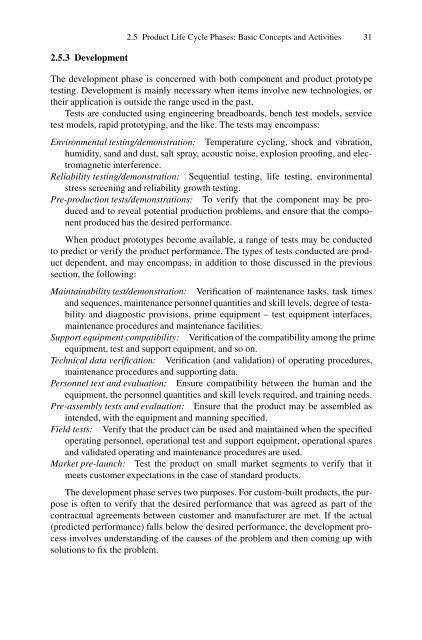9781848002708-c1
Create successful ePaper yourself
Turn your PDF publications into a flip-book with our unique Google optimized e-Paper software.
2.5.3 Development<br />
2.5 Product Life Cycle Phases: Basic Concepts and Activities 31<br />
The development phase is concerned with both component and product prototype<br />
testing. Development is mainly necessary when items involve new technologies, or<br />
their application is outside the range used in the past.<br />
Tests are conducted using engineering breadboards, bench test models, service<br />
test models, rapid prototyping, and the like. The tests may encompass:<br />
Environmental testing/demonstration: Temperature cycling, shock and vibration,<br />
humidity, sand and dust, salt spray, acoustic noise, explosion proofing, and electromagnetic<br />
interference.<br />
Reliability testing/demonstration: Sequential testing, life testing, environmental<br />
stress screening and reliability growth testing.<br />
Pre-production tests/demonstrations: To verify that the component may be produced<br />
and to reveal potential production problems, and ensure that the component<br />
produced has the desired performance.<br />
When product prototypes become available, a range of tests may be conducted<br />
to predict or verify the product performance. The types of tests conducted are product<br />
dependent, and may encompass, in addition to those discussed in the previous<br />
section, the following:<br />
Maintainability test/demonstration: Verification of maintenance tasks, task times<br />
and sequences, maintenance personnel quantities and skill levels, degree of testability<br />
and diagnostic provisions, prime equipment – test equipment interfaces,<br />
maintenance procedures and maintenance facilities.<br />
Support equipment compatibility: Verification of the compatibility among the prime<br />
equipment, test and support equipment, and so on.<br />
Technical data verification: Verification (and validation) of operating procedures,<br />
maintenance procedures and supporting data.<br />
Personnel test and evaluation: Ensure compatibility between the human and the<br />
equipment, the personnel quantities and skill levels required, and training needs.<br />
Pre-assembly tests and evaluation: Ensure that the product may be assembled as<br />
intended, with the equipment and manning specified.<br />
Field tests: Verify that the product can be used and maintained when the specified<br />
operating personnel, operational test and support equipment, operational spares<br />
and validated operating and maintenance procedures are used.<br />
Market pre-launch: Test the product on small market segments to verify that it<br />
meets customer expectations in the case of standard products.<br />
The development phase serves two purposes. For custom-built products, the purpose<br />
is often to verify that the desired performance that was agreed as part of the<br />
contractual agreements between customer and manufacturer are met. If the actual<br />
(predicted performance) falls below the desired performance, the development process<br />
involves understanding of the causes of the problem and then coming up with<br />
solutions to fix the problem.



